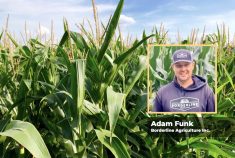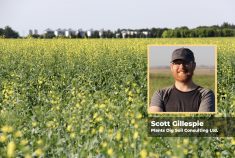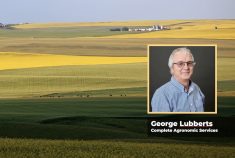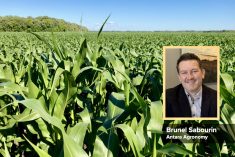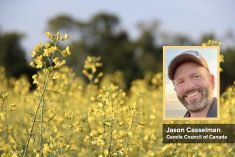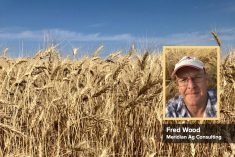Soybeans have expanded well beyond their traditional base in Manitoba’s Red River Valley, so growers even farther west into Saskatchewan are giving them a close look.
But they might want to wade through the hype before making any big decisions, says one agronomist who’s been working with new growers.
Dieter Schwarz, a market development agronomist with Pride Seed, says this region is unproven ground for a crop that developed biologically under much different conditions.
“This is, originally, a warm-season crop,” Schwarz told Country Guide. “Growers need to really start small and see how a variety, even the short-season varieties, actually performs in their own local growing area.”
Read Also

Agronomists share tips for evaluating new crop products and tech: Pt. 3
With new products, new production practices and new technology converging on the agriculture industry at a frenetic pace in recent…
Schwarz says he knows growers who reliably get 50 to 60 bushels an acre of canola but who have tried certain soybean varieties only to find yields in the low 30s, which simply won’t pay the bills.
“I’ve heard a lot of growers say they need $500 an acre in income from their canola crop — if they’re not getting at least 50 bushels of canola an acre, they’re losing money,” Schwarz says. “It is important to know your costs for your operation, and to research local crop yields in an effort to create realistic cropping budgets for growing soybeans.”
Schwarz adds it’s extra important with soybeans because going into the crop in a big way requires substantial investment in specialized equipment like flex headers, air reels and even conveyor systems.
It’s surprisingly blunt talk from a company representative who wants to see growers trying beans, but Schwarz says the goal isn’t to talk growers into putting more soybeans in the ground — it’s making sure they make money when they do. If they do, a viable soy industry in Western Canada will be possible. If they don’t, soybeans will be a flash in the pan.
Says Schwarz, “I don’t want to rush out just to be the first, and have growers be disappointed.”
Frost cools enthusiasm
Another observer says the hype might have enticed a few growers in Saskatch-ewan, but reality is starting to set in. Dale Risula, a pulse crop specialist with the Saskatchewan Agriculture Department, told Guide a frost in early last September seems to have slowed interest this season.
“We saw soybean production in Saskatchewan go from about 50,000 acres to 300,000 acres in just three seasons,” Risula says. “But I think that early frost knocked it back a bit, and slowed that growth. It’s still there, and there’s still a lot of interest, but acreage has crept back a bit.”
This pattern isn’t unfamiliar, and likely reflects the learning curve that comes with any new crop. Schwarz says that at least initially there was a lot of hype around soybeans in non-traditional areas, and as growers gain experience, they’re learning it’s a crop with risks like any other.
“Thankfully a lot of growers are realizing that soybean isn’t necessarily a low-input crop,” Schwarz says. “They reality is a good soybean crop will take off 85 pounds of phosphorus… If you’re not fertilizing you’ll hate yourself the next season.”
That’s not to say there aren’t fertility advantages — soybeans fix their own nitrogen from the air — but even that process requires some knowledge and management.
“Soybeans require a different inoculant than peas and lentils, and it’s not naturally present in our soils,” Risula says. “Growers will need to make sure they’re inoculating, and inoculating with the right type of product.”
Pride Seed’s Schwarz echoes that sentiment, saying he’s seen and heard of some real wrecks when this doesn’t happen.
“Some growers put bare seed in the ground, and that’s a recipe for disaster,” he says. “We recommend full fungicide — and possibly insecticide, depending on field scouting — as well as a double inoculant.”
So that would mean inputs right on the seed itself, then an additional eight pounds an acre granular application in furrow at seeding time on new soybean ground.
Even at that, growers who are used to seeing residual nitrogen from other pulse crops may find themselves surprised and even disappointed by what’s left at the end of the season, Schwarz says.
“Soybean is no soil builder, like peas or lentils,” he says. “A healthy soybean crop will require 200 pounds of nitrogen in the season.”
Risula says one strategy growers might want to consider when picking a field is finding one that’s very low in N, because the crop will pump nitrogen out of the soil it turns to its nodules to fix that “free” nitrogen in the air.
Clean field is imperative
Risula also says the crop isn’t terribly competitive early in the season until it begins to bush out and starts to choke out weeds. That means a clean field is imperative, starting with both a pre-seeding burn-off and an in-season application. Schwarz adds that the presence of Roundup Ready canola could also complicate this challenge, and add some expense.
“That means more than just a cheap and simple glyphosate application — it’s going to take some more expensive products, things like Odyssey, Viper or Heat,” Risula says.
In the end it’s going to go back to a bit of old-fashioned trial-and-error agronomy and Schwarz suggests keeping a close eye on what’s happening close to home. Soybean is a plant that reacts fairly dramatically to things like changes in the photoperiod, so observing the crop under local conditions will be key.
“If you have some neighbours who are growing soybeans, talk to them, keep a close eye over their fence, maybe even ride the combine with them for a bit if you’re done harvesting wheat and canola,” Schwarz says. “There is nothing that will substitute for local research and production experience.”
In fact Schwarz says soybean production should start as early as possible the year before, by getting as much of this information together as possible, and reconciling it with what’s known about local growing conditions. Picking a field is a key part of the decision. Risula says land type plays an important role. Soybeans can handle a bit wetter feet than canola and really don’t like drying out, as the plant developed naturally in high-rainfall environments.
“When we talk about soil types for soybeans we’re really looking at clay and clay loam,” Schwarz says. “Avoid sand because dry conditions will really hit yield.”
Schwarz also notes that heavier soils can help retain moisture for crucial periods during growth, like right after the last pods appear in late July and very early August.
“We call those the bonus beans, and if you want those pods to fill you really need some rainfall right then, or a heavier soil that has retained some moisture,” he says. “I always tell people if they want really good soybeans, they might have to be OK with No. 2 wheat that season because of this.”
One thing both Schwarz and Risula agree on is the importance of truly understanding the crop and getting past the hype, something Risula says should be any potential soy producer’s mantra.
“Prepare, prepare, prepare,” he says. “Do your research, prepare your ground this year, and be ready for next year.”
Despite sounding a note of caution, Schwarz says he remains overall quite positive for soybeans as a part of the western Canadian rotation, over time. In the end there are just too many compelling reasons to try to make it work.
“It’s an excellent addition to a crop rotation,” he says. “It adds a pulse crop, it gives you a break on your canola disease cycle, and has the potential to be nicely profitable.”
This article originally appeared in the October 2015 issue of the Soybean Guide




